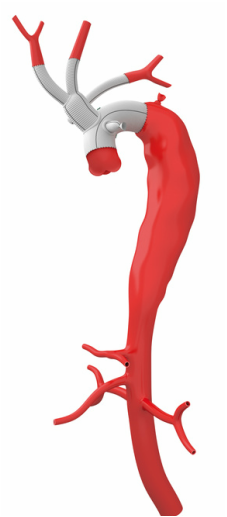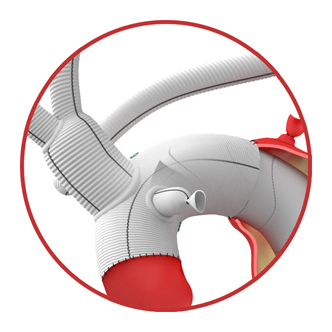Aortic Arch Aneurysms
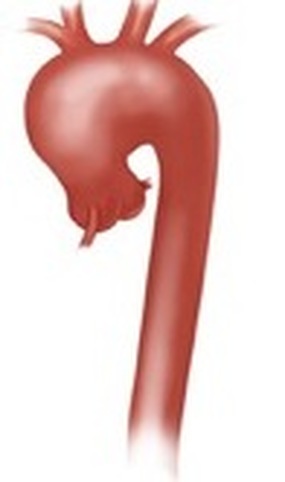
Aortic arch aneurysm
The aortic arch is the segment of aorta between the inominate artery and subclavian artery. This segment gives off the arteries to the brain, neck, face, and upper extremities. It connects the ascending aorta to the descending aorta, crossing from the front part of the chest to the back. As the diagram in the anatomy section details, this segment of aorta resembles an arc. The replacement of this segment of aorta for an aneurysm requires intricate and sophisticated techniques.
The aortic arch aneurysms are commonly caused by atherosclerosis, infection, and dissection. The infections of the aortic arch are as a result of a blood-borne microorganism, which seeds an atherosclerotic plaque. The bacterial infection results in weakening of the aortic wall resulting in a mycotic aneurysm. Aortic dissections involving an aortic arch usually are a result of a Type A aortic dissection, where the false channel involves the ascending aorta. Localized aortic dissections of the aortic arch are uncommon. Atherosclerotic plaques are found in the aortic arch which can be the source of stokes or other embolic events (dislodgement of a piece of calcium or atherosclerotic debris and traveling to another part of the body through the bloodstream). Occasionally, the atherosclerotic changes can be so advanced that the inside of the aorta appears like stalagmites and a cauliflower on echocardiogram.
Presentation/Symptoms
A significant percentage of aortic arch aneurysms are asymptomatic. Aortic arch aneurysms are usually found incidentally on plain chest x-rays. As the aneurysm expands the symptoms which ensue are related to compression of surrounding structures like the trachea and esophagus. A patient may develop hoarseness from stretching a nerve that goes to the vocal cords. A large pulsation in the neck may be felt or seen in the lower neck.
The aortic arch aneurysms are commonly caused by atherosclerosis, infection, and dissection. The infections of the aortic arch are as a result of a blood-borne microorganism, which seeds an atherosclerotic plaque. The bacterial infection results in weakening of the aortic wall resulting in a mycotic aneurysm. Aortic dissections involving an aortic arch usually are a result of a Type A aortic dissection, where the false channel involves the ascending aorta. Localized aortic dissections of the aortic arch are uncommon. Atherosclerotic plaques are found in the aortic arch which can be the source of stokes or other embolic events (dislodgement of a piece of calcium or atherosclerotic debris and traveling to another part of the body through the bloodstream). Occasionally, the atherosclerotic changes can be so advanced that the inside of the aorta appears like stalagmites and a cauliflower on echocardiogram.
Presentation/Symptoms
A significant percentage of aortic arch aneurysms are asymptomatic. Aortic arch aneurysms are usually found incidentally on plain chest x-rays. As the aneurysm expands the symptoms which ensue are related to compression of surrounding structures like the trachea and esophagus. A patient may develop hoarseness from stretching a nerve that goes to the vocal cords. A large pulsation in the neck may be felt or seen in the lower neck.
Treatment Options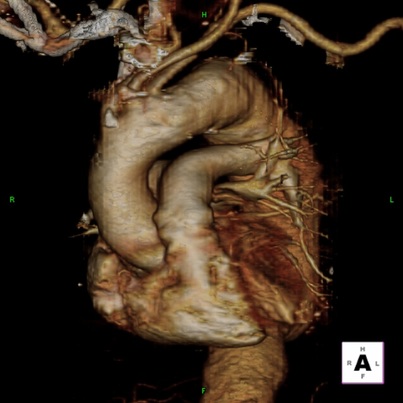
The treatment of aortic aneurysm is based on the cause, symptom and size. In general, atherosclerotic aneurysms greater than or equal to 6 cm and chronic dissection of the aortic arch of greater than or equal to 5 cm should be considered for repair. A symptomatic aortic arch, regardless of size, should be offered surgical intervention. Pseudoaneurysms of the aortic arch are commonly seen secondary to penetrating ulcers and should be carefully monitored for growth and intervened with maximum diameter of 5 cm or symptoms. Likewise, mycotic aneurysm (infected aneurysms) usually develop on the site of a penetrating atherosclerotic ulcer of the aortic arch. The treatment for mycotic aneurysms includes long-term antibiotics and surgical repair. 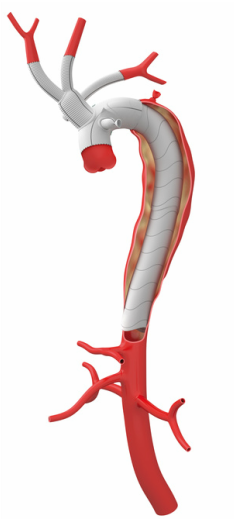
This photograph shows the endovascular repair of the descending thoracic aorta. This patient had an appropriate landing zone for the stent above the celiac artery.
|
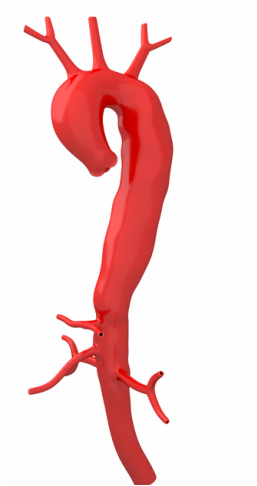
This a typical patient with an aortic arch aneurysm and thoracoabdominal aortic aneurysm. There are several options which include a two-staged approach. A traditional open arch replacement (Elephant trunk procedure) and second stage which is a open thoracoabdominal aortic aneurysm repair. If possible the second stage can be performed with an endovascular stent. |
